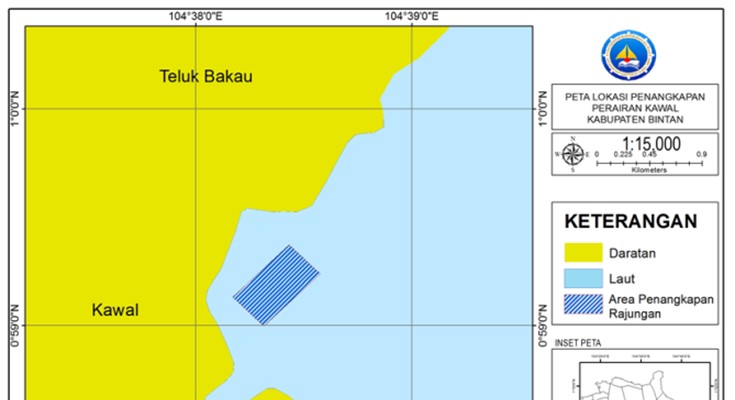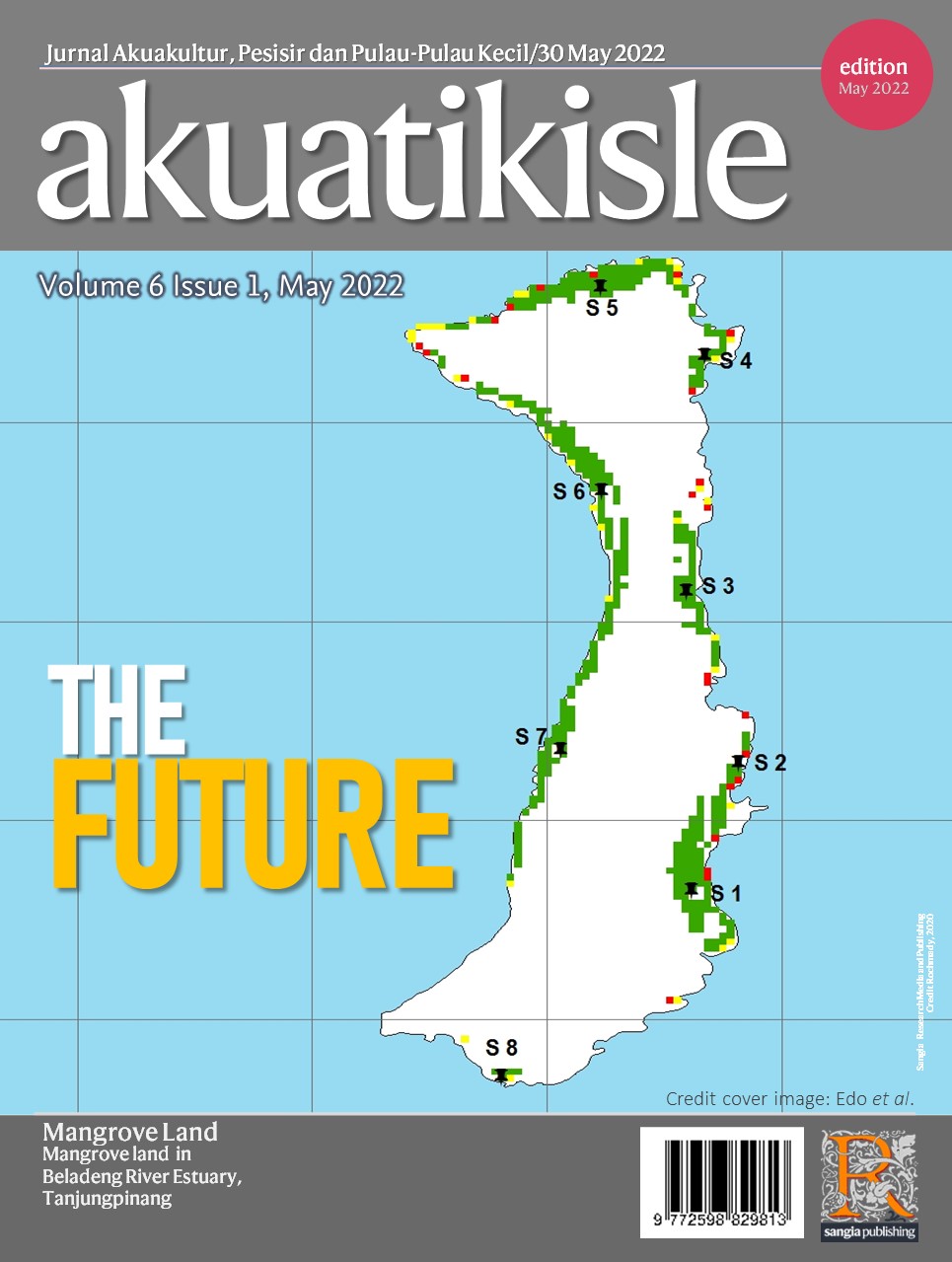Akuatikisle: Jurnal Akuakultur, Pesisir dan Pulau-Pulau Kecil
Full Length Article
Feeding habit of blue swimming crab (Portunus pelagicus) in Kawal Waters, Bintan Regency
Highlights
Generate NLP AI by Wizdam ID.
Abstract
Kawal Waters is one of the waters in Bintan which has good fishery resources, one of that is the blue swimming crab. The Blue Swimming Crab (Portunus pelagicus) is one of the important economic fisheries resources belonging to the Portunidae family. The blue swimming crab is one of the most common organisms used by the community. The purpose of the study was to determine food composition of blue swimming crab (Portunus pelagicus) in Kawal waters of Bintan Island, Riau Island on June 2021. The sampling used random sampling method. There were 34 individuals used for food composition analysis. The food composition in the stomach of blue swimming crab consisted of three groups of microalgae, crustacea, and detritus. The food composition in the adult size was found microalgae groups with the percentage composition 78%. It was followed by crustacea of 18,06%, and detritus of 5,12%. The highest of indeks of stomatch contens is in morning caught of 1,15 for males and 1,28 for female.
Keywords
Introduction
Section snippets
Material and Methods
Materials and methods from the full-text PDF of this article cannot be displayed.
Results
Results from the full-text PDF of this article cannot be displayed.
Discussion
Discussion from the full-text PDF of this article cannot be displayed.
Conclusions
Conclusions from the full-text PDF of this article cannot be displayed.
Acknowledgment
Acknowledgment from the full-text PDF of this article cannot be displayed.
Competing interest
The authors declare that they have no known competing financial interests or personal relationships that could have appeared to influence the work reported in this paper.
Conflict of interest
The authors declare that the research was conducted in the absence of any commercial or financial relationships that could be construed as a potential conflict of interest.
Ethical approval acknowledgements
No ethical approval required for this article. All procedures followed were in accordance with the ethical standards of the responsible committee on human experimentation (institutional and national) and with the Helsinki Declaration of 1975, as revised in 2008 (5)
Supplementary files
Data sharing not applicable to this article as no datasets were generated or analysed during the current study, and/or contains supplementary material, which is available to authorized users.
References (1)
Basani Nur Pasaribu. 2017. Makanan dan Kebiasaan Makan Kepiting Bakau (Syclla serrata Forskal 1779) di Perairan Kampung Sentosa Barat Kelurahan Belawan Sicanang Kecamatan Medan Belawan. [Skripsi]. Universitas Sumatera Utara. Medan.
Effendi, M.I. 2002. Biologi Perikanan Yayasan Pustaka Nustama. Yogyakarta.
Erlinda, S., La Sara., Nur Irawati. 2016. Makanan Rajungan (Portunus pelagicus) di Perairan Lakara Kabupaten Konawe Sulawesi Tenggara. Jurnal Manajemen Sumberdaya Perairan; 1(2): 131-140.
Fatmawati. 2009. Kelimpahan relatif dan struktur ukuran rajungan di daerah mangrove kecamatan Tekolabbua Kbupaten Pangkep. {Skripsi}. Jurusan Perikanan Fakultas Ilmu Kelautan dan Perikanan Universitas Hasanuddin. Makassar.
Ismail T, Muchlisin Z.A, Fadli N., Setiawan I. 2013. Kebiasaan Makan dan Komposisi Makanan Tiga Spesies Cumi (Loligo edulis, Sepioteuthis lessoniana dan Sepia officinalis) Hasil Tangkapan Nelayan dari Perairan Pantai Utara Provinsi Aceh. Depik 2(2): 97-103.
Kristoval T, Ita Karlina, Hengky Irawan. 2016. Studi Ekologi Kepiting Bakau dan Kepiting Rajungan di Perairan Batu Licin Kecamatan Bintan Timur Kabupaten Bintan. Jurusan Ilmu Kelautan. Fakultas Ilmu Kelautan dan Perikanan. Universitas Maritim Raja Ali Haji. Tanjungpinang.
Muchlisin, Z.A. 2011. Buku ajar ikhtiologi. Koordinatorat Kelautan dan Perikanan Universita Syiah Kuala. Banda Aceh.
Nezaputri, A. N. 2020. Makanan dan Kebiasaan Makan Siput Gonggong (Laevistrombus turturella) di Perairan Pulau Penyengat Kota Tanjungpinang. [Skripsi]. Universitas Maritim Raja Ali Haji. Tanjungpinang.
Nurcan. 2017. Manajemen Pengolahan Kepiting Rajungan (Portunus pelagicus) Pengupasan Kulit di UD. Padaidi Bontang Kalimantan Timur. [Skripsi]. Politeknik Pertanian Negeri Pangkep. Pangkep.
Pemerintah Daerah Kabupaten Bintan tentang Geografis Kabupaten Bintan. Diakses pada tanggal 3 Maret 2021. bintankab.go.id/geografis.
Permen KP. 2016. Larangan Penangkapan dan/atau Pengeluaran Lobster (Panulirus sp.), Kepiting (Scylla sp.), dan Rajungan (Portunus sp.) dari Wilayah Negara Republik Indonesia No.56.
Prasetyo G.D, A.D.P. Fitri, dan T.Yulianto. 2014. Analisis daerah penangkapan rajungan (Portunus pelagicus) berdasarkan perbedaan kedalaman perairan dengan jaring arad (mini trawl) di Perairan Demak. Journal Fisheries Resources Utilization Manangement and Technology, 3(3): 257-266.
Rusmadi, Henky Irawan, Falmi Y. 2014. Studi Biologi Kepiting di Perairan Teluk dalam Desa Malang Rapat Kabupaten Bintan Provinsi Kepulauan Riau. Fakultas Ilmu Kelautan dan Perikanan. Universitas Maritim Raja Ali Haji. Tanjung Pinang.
Yanto F., Susiana, Muzammil W. 2020. Utilization rate of brown strip red snapper (Lutjanus vitta) on Mapur Waters that landing in Kelong Village, Bintan Pesisir Sub Dsitrict, Bintan Regency. Jurnal of Tropical Fisheries Management. 4(2): 1-9.
Bibliographic Information
Cite this article as:
-
Submitted
5 August 2021 -
Revised
30 August 2021 -
Accepted
6 September 2021 -
Published
20 December 2021 -
Version of record
30 May 2022 -
Issue date
1 May 2022
-
Academic subject
Fisheries Science; Marine Science
Copyright
Sangia Advertisement
Copyright © 2021 Yolanda, L., Susiana, S., & Muzammil, W.. Sangia Research Media and Publishing. Production and hosting by Sangia (SRM™).  This work is licensed under a Creative Commons Attribution-ShareAlike 4.0 International License.
This work is licensed under a Creative Commons Attribution-ShareAlike 4.0 International License.
Disclaimer: All claims expressed in this article are solely those of the authors and do not necessarily represent those of their affiliated organizations, or those of the publisher, the editors and the reviewers. Any product that may be evaluated in this article or claim that may be made by its manufacturer is not guaranteed or endorsed by the publisher.
Comments on this article
By submitting a comment you agree to abide by our Terms and Community Guidelines. If you find something abusive or that does not comply with our terms or guidelines please flag it as inappropriate.










